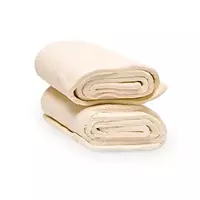Puff pastry

Quite often, many housewives use puff dough to prepare a variety of culinary and confectionery products. Pies, cakes, puffs with sweet fillings and more - the choice of dishes is really multifaceted. Compared to some other types, the calorie content of puff dough is significantly higher at about 337 kcal per 100 grams. In this regard, dishes that include this product should not be abused by people with increased body weight.
In general, laminated dough products are the innermost layers of dough that easily separate from each other. They are crisp on top and tender and soft on the inside.
Puff pastry composition
Regarding the composition of the puff dough, wheat flour, water, butter and salt are the main components. By the way, sometimes, for example, margarine can be seen instead of oil, which is why the calorie content of puff dough can vary slightly. Such dough, which serves as the basis for baking crispy, toasted products, requires special attention and accuracy during its preparation.
Depending on the ingredients that are included in the puff dough, this product is usually divided into 2 types: classic and simplified. Undoubtedly, the classic puff dough has a higher quality of finished products, but it is also quite difficult to prepare. That is why many hostesses prefer to buy a ready-made store product.
If you do decide to make puff dough yourself at home, remember that to prepare the classic version, you first need to knead soft dough, which consists of flour, water and salt, and then roll cold butter into it in thin layers. The more such layers, the higher the dough quality, respectively. Connoisseurs claim that there are approximately 140 layers in the best layered dough. Sometimes these numbers can reach up to 240! It is almost impossible to distinguish these thinnest layers with the naked eye, and cooking takes a very long time, but believe me, it is worth it.
If you still do not dare and choose the finished ice cream layer dough, do not forget that here you need to follow some rules. First of all, the dough should thaw on its own. If it has been frozen by the formations, they should first be separated from each other and then separately thawed for about 20 minutes. Thawed layers of layer dough are wetted with cold water, stacked and rolled into a single layer to the desired thickness and size.
It is necessary to roll out the dough with a rolling pin and there are also tricks: first from right to left, after which - on the contrary, then - from bottom to top and top to bottom, that is, always in the same direction. This is done so that the layers are not damaged, and the finished product rises when baking.
It is customary to bake the puff pastry on a baking sheet, which is pre-wetted with cold water rather than oiled as usual. This is done on the basis of two considerations: firstly, during the baking process, the water evaporates, giving the dough an additional volume. And secondly, the fat (oil or margarine) that is included in the product during baking significantly increases in volume, thereby releasing water dissolved in the dough. Due to the fact that the liquid turns into steam, the layers rise, separating from each other, as a result of which the dough delamination process occurs.
337.2 kCal puff dough
Energy value of puff dough (Ratio of proteins, fats, carbohydrates - ju):
Proteins: 5.9 g (~ 24 kCal)
Fats: 18.5 g (~ 167 kCal)
Carbohydrates: 39.3g (~ 157 kCal)
Energy ratio (b | y): 7% | 49% | 47%
 Español
Español Français
Français Português
Português Русский
Русский 简体中文
简体中文 繁體中文
繁體中文 日本語
日本語 한국어
한국어 العربية
العربية Türkçe
Türkçe Қазақ
Қазақ Deutsch
Deutsch Italiano
Italiano Українська
Українська
